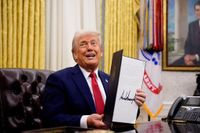The U.S. stock market has faced a significant downturn since President Donald Trump took office, with a staggering 10% drop marking the worst start for a new president in over two decades. This decline, which has unfolded over the first ten weeks of his administration, is reminiscent of the tumultuous early days of President George W. Bush in 2001, during the height of the dot-com bubble burst.
Since Trump's inauguration on January 20, 2025, the S&P 500 Index has entered a correction phase, shedding more than $3 trillion in value. This figure is alarming, especially when compared to the initial market performances of the past five presidential administrations. The only worse start recorded was the approximately 18% drop experienced during Bush's first term.
The catalyst for this market upheaval appears to be Trump's recent announcement of steep tariffs, which he heralded as a move to "Make America Wealthy Again." However, the reality has been quite the opposite. On April 2, 2025, Trump imposed tariffs of at least 10% on all exporters to the U.S., with even higher rates targeting specific countries such as China, Vietnam, Japan, and the European Union. This announcement triggered a rapid selloff in risk assets, culminating in a dramatic 4% drop in the S&P 500 the following day.
Brian Mulberry, a client portfolio manager at Zacks Investment Management Inc, noted, "What you’re seeing is the market’s reaction to just how much has changed in that short period of time." He emphasized that investors are grappling with the uncertainty surrounding these new policies.
As traders reacted to the new tariffs, a broad array of U.S. equities faced significant losses. Notably, shares of Apple Inc., which have substantial exposure to China, plummeted by more than 9%, erasing over $260 billion in market value. Similarly, companies like Lululemon Athletic Inc and Nike Inc saw their shares decline by roughly 13%, reflecting the anxiety surrounding manufacturing ties to Vietnam.
Art Hogan, chief market strategist at B Riley Wealth Management, commented, "We removed one layer of uncertainty only to bring another layer of uncertainty." The fear among investors is that these tariffs could stifle economic growth and potentially lead the country into a recession.
This economic turmoil comes at a time when Trump's job approval rating remains relatively stable at around 48%, just slightly lower than in early February 2025. Despite the political challenges he faces, the president's support appears to have remained intact, with many Americans believing the country is on the right track.
However, the political landscape is shifting. Trump's recent policies have increasingly catered to his core base, raising concerns among moderates. His administration's push for tariffs on traditional allies and proposals like annexing Canada have raised eyebrows among the political center, which could jeopardize his support in upcoming elections.
The recent special election defeat in Wisconsin's state Supreme Court race for Trump-backed candidate Brad Schimel has sparked discussions about the potential risks of alienating moderate voters. While Democrats have consistently turned out in greater numbers during special elections, it remains to be seen how this trend will affect general elections.
Political analysts warn that if Trump continues to prioritize hardline policies that resonate primarily with his base, he may replicate the mistakes of previous presidents who veered away from centrist policies after taking office. Bill Clinton, George W. Bush, Barack Obama, and Joe Biden all faced backlash for failing to follow through on their campaign promises to represent the center of public opinion.
Clinton's presidency serves as a cautionary tale; despite campaigning as a "new Democrat" focused on reforming welfare and reducing crime, he quickly shifted leftward once in office, facing a significant rebuke in the 1994 midterms. Similarly, Bush's focus on Social Security reform after 9/11 alienated moderates, leading to disastrous midterm losses for the GOP in 2006.
Trump's unique position lies in his ability to harness the disillusionment of voters who feel abandoned by mainstream politicians. However, his recent focus on divisive issues like tariffs and immigration could fracture the coalition he built during his campaign.
Polling indicates that while Trump's base remains loyal, a significant portion of the electorate is wary of his more extreme proposals. About 60% of registered voters have a favorable opinion of NATO, and a vast majority believe that a president should obey court orders, even if they disagree with them. This suggests that Trump's hardline approach may not resonate with the broader public.
As the nation approaches the 2026 midterms, Trump's ability to maintain support among moderates will be crucial. If he can pivot back to policies that appeal to a wider audience, he may be able to solidify his position. Analysts suggest that he should focus on practical issues that unite rather than divide, such as economic growth and national security.
Trump's administration has already made strides in addressing illegal immigration and promoting economic initiatives. However, he must also communicate clearly the rationale behind his policies, especially regarding tariffs, to alleviate concerns among swing voters.
Looking ahead, the upcoming 250th anniversary of the Declaration of Independence presents an opportunity for Trump to rally Americans around shared ideals. By emphasizing unity and a clear vision for the future, he could counteract the growing polarization that has characterized recent political discourse.
In summary, the current state of the U.S. stock market reflects broader economic uncertainties tied to Trump's policies. As the president navigates the complexities of governing amid a polarized political landscape, the choices he makes in the coming months will be pivotal for his legacy and the future of the Republican Party.






